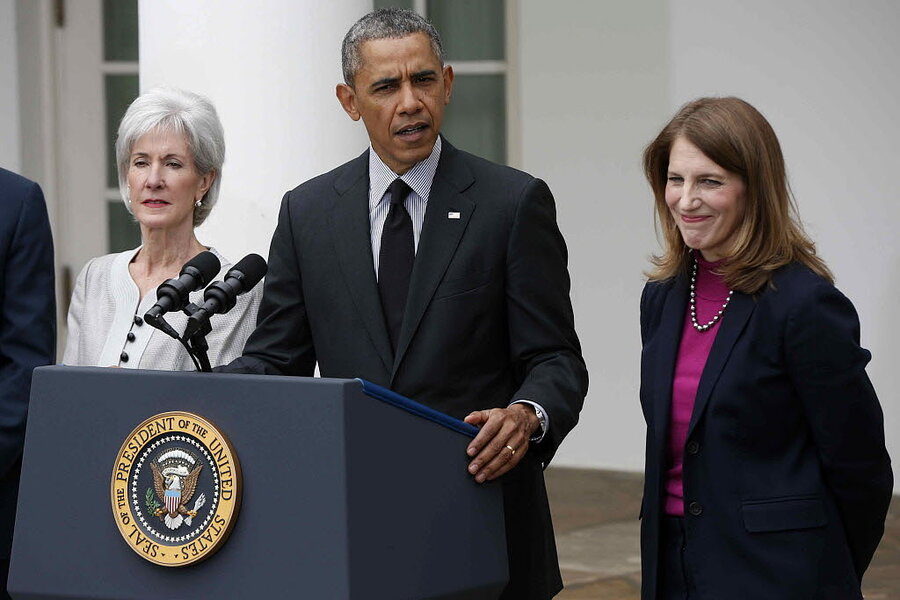Obamacare's next chapter: More insurance firms opting 'in' than 'out'?
Loading...
| WASHINGTON
President Obama’s health-care exchanges appear poised to keep growing – not just in the number of people enrolled but in the number of insurance firms participating and offering coverage.
That’s the early indication, at least, as the 2014 enrollment period closes and as insurers begin to ramp up their plans for the next year’s cycle.
For consumers, the good news is that the trend promises added competition that could help restrain the pace of price hikes.
For the architects of the law, which was designed to make insurance accessible to more Americans, the number of private insurance firms participating is an important barometer of Obamacare’s success.
“At this point not very many insurers [are] pulling out,” says Jenna Stento, a senior manager at Avalere Health in Washington, a provider of information and advisory services in the health-care industry. The trend “doesn’t seem to be going in the direction of less competition.”
She says the Blue Cross family of insurers, for example, looks likely to expand its presence from 47 states in the first year of the Affordable Care Act (ACA) exchanges to 49 states when enrollment starts for 2015.
Another straw in the wind: The directors of three state exchanges under the ACA told reporters on a recent conference call that they expect new insurance companies on the playing field for 2015. Those states were California, Kentucky, and Washington.
And in New Hampshire, with only one insurer selling on its exchange for 2014, two more firms are expected to offer coverage in 2015, according to news reports.
Ms. Stento says it’s too early to know how the 2015 landscape will shake out. Some large players in the industry – Aetna, Humana, and Cigna for example – have been keeping quiet about their intentions, she says.
Some other insurance providers, such as Kaiser Permanente, won’t be expanding much simply because they already “opted in” by offering Obamacare plans in the markets where they operate.
Perhaps what’s most significant is what doesn’t seem to be occurring – big retreats from the marketplaces in 2015.
The ACA calls for each state to have a marketplace where the uninsured can shop if they don’t have coverage from an employer or some other source. The law called on individuals to have insurance by 2014, or potentially owe a tax penalty. And it set up means-tested subsidies available to shoppers on the exchanges.
The official sticker prices of the plans with labels like “silver” and “bronze” aren’t cheap. But the idea is that if enough people are shopping and enough companies are competing to serve them, price hikes will be contained somewhat.
The enrollment period for 2014 is ending as of April 15, according to the Health and Human Services Department, which had granted a grace period for people who failed to complete their sign-ups by a March 31 deadline.
According to the agency’s tally, more than 7.5 million people enrolled across the country, better than many forecasters expected after website technical challenges overwhelmed the early phase of enrollment.
The next big question – one that will be answered very soon – is how insurers will shape the marketplace offerings for 2015. Enrollment doesn’t start until November, but firms need to decide in the coming weeks if they want to offer plans – and how to price them.
Obamacare’s success remains far from assured. A couple of the key questions that remain are these: How well will the law do on its central goal of reducing the ranks of the uninsured? Will the exchanges prove popular with consumers by delivering on both quality care and price?
Those issues are linked, because many of the remaining uninsured Americans are people who chose not to enroll for 2014, either because they didn’t want the coverage or couldn’t afford it.
One early complaint from exchange shoppers has been that insurers aren’t offering access to enough doctors. Consumers are very price conscious, so insurers are focused on careful management of their costs.
Avelere analyst Stento says large insurers may not raise their rates a lot for 2015, partly because they didn’t start with unrealistically low pricing in 2014.
Another factor may be that it’s still early for the firms to know how expensive the Obamacare enrollees are to cover, compared with expectations.
In a report this week, the Congressional Budget Office predicted that premiums on the exchanges, on average, will post only a modest rise in 2015, less than 3 percent. But then premiums would start rising a bit faster, by about 6 percent a year through 2024, the report predicted.
A final thought: Extra competition among insurers won’t necessarily help all shoppers on the exchanges get better deals. That’s because the competition can affect the size of the Obamacare subsidies (which are keyed to the second-lowest silver plan price in a market) as well as the premiums.
But if competition restrains the rate of price hikes, that would generally be a good thing, many health policy experts say.






